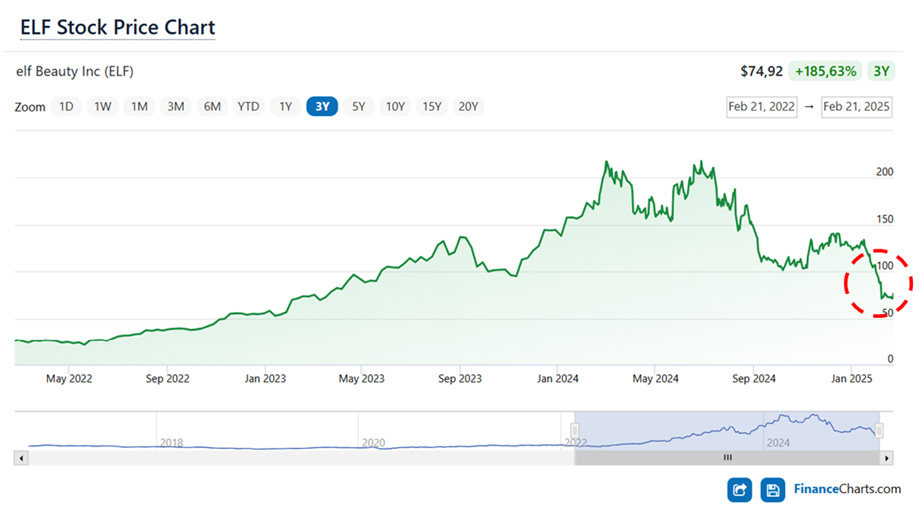Introduction
This is my second deep dive into a beauty company, and once again, the starting point is a significant stock price pullback. In my previous analysis, I examined Ulta Beauty (ULTA) when it was trading down ~30% from its peak, ultimately deciding to stay on the sidelines. Today, the situation with e.l.f. Beauty (ELF) is even more pronounced—the stock has fallen more than 65% from its all-time high, raising questions about whether this represents a compelling buying opportunity.
But before diving into valuation, it’s crucial to analyze what’s driving this decline. e.l.f. Beauty has been one of the fastest-growing and most disruptive brands in the industry, known for its high-quality, affordable beauty products and strong digital marketing execution. The company has built a unique business model, leveraging viral social media engagement, rapid innovation, and retail expansion to fuel sustained outperformance.
However, despite its strong execution and financial performance, e.l.f. is now facing a set of headwinds and uncertainties that have led the market to reassess its growth trajectory. This article aims to evaluate these challenges—determining whether they are temporary or structural—and assess whether e.l.f. still has the capacity to outperform in the future.
The analysis will be structured as follows:
1. Identify and analyze the key headwinds impacting e.l.f.’s stock price.
2. Assess e.l.f.’s competitive advantages and long-term growth levers.
3. Conclude with an investment perspective, evaluating whether e.l.f. remains a compelling long-term growth story.
Let’s dive in.
Headwinds and uncertainties: assessing the risks facing e.l.f. Beauty
As commented, despite e.l.f.’s exceptional growth and industry-leading execution, the company is currently navigating several key headwinds that have led the market to reassess its growth trajectory and valuation. Below, I analyze the primary challenges affecting e.l.f.’s stock performance and evaluate whether these concerns are temporary or structural.
1. Macro challenges in the beauty sector
One of the most immediate challenges is the moderation of growth in the beauty sector, particularly in the mass-market segment. While the prestige beauty category continues to perform well, mass cosmetics have shown signs of slowing. Retailers have become more cautious with their inventory replenishment, leading to lower order volumes despite strong sell-through rates. This cautious approach stems from broader macroeconomic uncertainty, as inflationary pressures have impacted discretionary spending, particularly among lower-income consumers. While e.l.f. has historically benefited from consumers trading down from prestige brands, any prolonged slowdown in mass-market beauty sales could lead to more volatile revenue growth in the near term. However, the company’s ability to outperform industry trends and take market share from legacy brands provides some insulation against these pressures.
However, these macro headwinds do not appear to be company-specific—ELF continues to significantly outperform the industry, gaining market share despite the broader slowdown. Once consumption trends stabilize and retailers normalize inventory levels, e.l.f. is well-positioned to reaccelerate growth.
2. Tariff risks and supply chain pressures
A potential increase in U.S. tariffs on Chinese imports poses a risk to e.l.f. Beauty, given that a majority of its products are manufactured in China through third-party suppliers. Higher tariffs could:
• Increase costs & compress gross margins – If tariffs on beauty imports rise, e.l.f. may face higher input costs, potentially pressuring margins.
• Lead to potential price increases – While e.l.f. has historically passed on some cost increases to consumers, further price hikes could test price elasticity in its core mass-market segment.
However, e.l.f. has successfully navigated tariffs before. In 2019, during the first round of tariffs, e.l.f. negotiated supplier concessions and implemented price increases without hurting margins or sales growth. Besides, today, e.l.f. is less vulnerable than in 2019, with less than 80% of sourcing in China (vs. ~100% in 2019) and higher international penetration (~20% of sales vs. ~10% in 2019), reducing U.S. tariff exposure.
While tariffs remain an external risk that could impact cost structures and short-term volatility, e.l.f.’s pricing power, supply chain flexibility, and strong demand suggest it can effectively manage the impact, as it has done in the past.
3. The threat of a TikTok ban in the U.S.
The potential banning of TikTok in the U.S. presents another uncertainty, given that e.l.f. has been one of the most successful beauty brands in leveraging the platform for marketing and consumer engagement. TikTok has played a crucial role in driving brand awareness, viral product adoption, and digital sales, particularly among Gen Z consumers. A ban would undoubtedly create short-term disruption, potentially slowing brand momentum and forcing e.l.f. to shift more of its marketing spend to alternative platforms, which could increase marketing expenses and hurt operating margins.
However, the company has already diversified its digital presence across multiple channels, reducing its dependency on any single platform. Additionally, its strong first-party data strategy, loyalty program (Beauty Squad with 5.6 million+ members), and growing direct-to-consumer sales provide alternative ways to maintain engagement with its core audience. While a TikTok ban would require adjustments in marketing strategy, it is unlikely to derail e.l.f.’s long-term brand momentum.
4. Increasing marketing expenses
As I will deeper analyze in coming paragraphs, e.l.f. also faces the challenge of managing rising SG&A expenses, particularly marketing costs. Over the past several years, the company has significantly increased its marketing spend and, while this investment has been a key driver of e.l.f.’s success, supporting brand awareness and consumer engagement, the question remains whether marketing intensity can gradually decline while sustaining strong growth. Management should be able to stabilize marketing investments over time as e.l.f. reaches brand maturity, but this remains a work in progress and an area for investors to monitor.
Is e.l.f. Beauty still a compelling growth story?
Keep reading with a 7-day free trial
Subscribe to JustValue to keep reading this post and get 7 days of free access to the full post archives.



